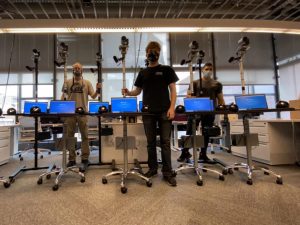by Erica K. Brockmeier

Since the start of the spring, members of the Penn community have been working to combat coronavirus and its many impacts. Some people are studying COVID-19 or developing vaccines, while others are 3D-printing face shields for health care workers and delivering fall courses online.
And while innovation in health care usually brings to mind new treatments and medicines, the efforts of clinicians, engineers, and IT specialists demonstrate the importance technological infrastructure for rapidly deployable, tech-based solutions so clinicians can provide the best care to patients amid social distancing and coronavirus restrictions.
The telemedicine revolution
In late March, telemedicine was key for allowing Penn Medicine clinicians to deliver care while avoiding potentially risky in-person interactions. Chief Medical Information Officer C. William Hanson III and his team helped set up the IT infrastructure for scaling up telemedicine capabilities and provided guidance to clinicians. Thanks to the quick pivot, Penn Medicine went from 300 telemedicine visits in February to more than 7,500 visits per day in a matter of weeks.
But far from seeing telemedicine as a temporary solution during the pandemic, Hanson has been a long-time advocate for this approach to health care. In his role as liaison between clinicians and the IT community in the past 10 years Hanson, helped establish remote ICU monitoring protocols and broadened opportunities for televisits with specialists. Now, with the pandemic removing many of the previous barriers to entry, be they technical, insurance-based, or simply a lack of familiarity, Hanson believes that telemedicine is here to stay.
“As the pandemic evolved, people were aware that telemedicine could help the health care system, as well as doctors and patients, during this crisis,” he says. “Now, there are definitely places where telemedicine makes good sense, and we will continue to use that as part of our way of handling a problem.” Other benefits include removing geographic barriers to entry for new patients, reduced appointment times, increased patient satisfaction, and reduced health care provider burnout.
Simple solutions for COVID-19 challenges
As the director of Penn’s Telestroke Program, neurologist Michael Mullen has experience diagnosing from a distance. This spring, telemedicine carts his group uses were repurposed in COVID ICUs. At the same time, Mullen and group wanted to expand their ability to assess stroke patients remotely, so he reached out to Brian Litt, faculty director of Penn Health-Tech, to see how he could collaborate to create an analogous telemedicine station using readily available, cost-effective components.
Rapid and simple solutions are at the heart of Penn’s ModLab, a subgroup of the GRASP lab focused on robots made of configurable individual components. As part of a COVID-19 rapid response initiative, engineers worked with Mullen to figure out a viable solution in record time. “The idea was to make it as simple and as fast as possible,” says graduate student Caio Mucchiani. “With robotics, usually you want to make things more sophisticated, however, given the situation, we needed to know how we could use off-the-shelf components to make something.”
Fellow graduate student Ken Chaney, postdoc Bernd Pfrommer, and Mucchiani came up with a plan that replicated the required specs of the existing telemedicine carts, including state-of-the-art cameras for detailed imaging as well as a reliable, easily rechargeable battery. The team then put together 10 telemedicine carts, assembling the prototypes with social distancing and masks at the GRASP lab in early April.
While changes to treatment approaches mean that these carts still require additional field testing, Mullen is still eager to expand the program, be it for diagnosing patients safely or educating medical students in an era of social distancing. “In the setting of COVID, when everything was getting crazy, it was remarkable to see the energy that GRASP brought to help,” adds Mullen. “Everyone was really busy, and it was amazing to see this group of people who wanted to use their expertise to help.”
Continue reading at Penn Today.
NB: Brian Litt is Professor in Neurology and Bioengineering.
